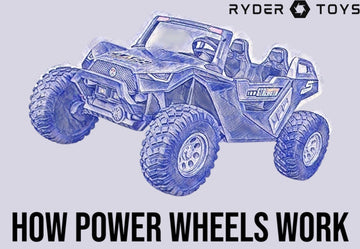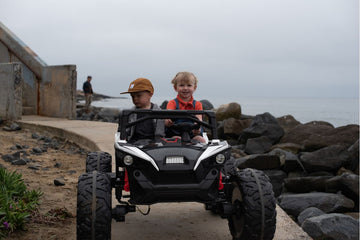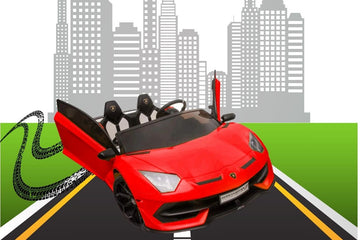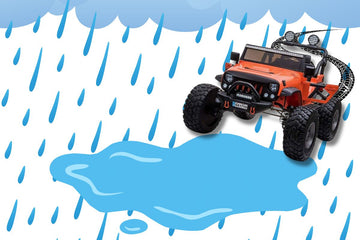Figure 1: Sketch up of the Ryder Toys All Wheel Drive Buggy. All of our designs start with pen and paper.
INTRODUCTION
HOW BATTERY-POWERED POWER WHEELS WORK: EXPLORING THE SCIENCE BEHIND THE RIDE-ON TOYS
Figure 2: The basic wiring diagram concept to transfer power from the battery to the motors of your ride on toy.
THE ELECTRICAL SYSTEM: CONVERTING BATTERY POWER INTO MOTION
-
The battery: This is the power source for the electric motor. Most battery-powered power wheels use 6- or 12-volt batteries that are rechargeable and designed to provide enough power to keep the vehicle running for several hours.
-
The motor: This is the device that converts electrical energy into mechanical energy, propelling the vehicle forward. Most battery-powered power wheels use a DC motor, which is highly efficient and easy to control.
-
The wiring: This is the network of electrical connections that links the battery to the motor, allowing electricity to flow between the two components.
-
The switch: This is the mechanism that turns the motor on and off. In most battery-powered power wheels, the switch is activated by the accelerator pedal.
Figure 3: Illustrations depicting the various types of wheel motors used in battery-powered toy cars
THE MECHANICAL COMPONENTS: TURNING MOTION INTO MOVEMENT
-
The wheels: This is where the rubber meets the road, so to speak. The wheels are connected to the motor via a series of gears or belts, which allow the motor's rotational energy to be transferred to the wheels.
-
The steering mechanism: This is the system that allows the driver to turn the vehicle left or right. Most battery-powered power wheels use a simple steering mechanism that allows the front wheels to pivot, changing the direction of the vehicle.
-
The frame: This is the structure that holds everything together. Most battery-powered power wheels are made from sturdy plastic or metal frames that are designed to withstand the wear and tear of regular use.
HOW BATTERY-POWERED POWER WHEELS WORK: A STEP-BY-STEP GUIDE
-
The driver sits in the seat and presses down on the accelerator pedal.
-
The switch is activated, sending electricity from the battery to the motor.
-
The motor begins to spin, transferring energy to the wheels via a series of gears or belts.The wheels begin to turn, propelling the vehicle forward.
-
The driver can use the steering mechanism to turn the vehicle left or right.
-
As the vehicle moves forward, the wind resistance and friction between the wheels and the ground slow it down. To maintain speed, the driver must continue to press down on the accelerator pedal.
-
When the battery begins to run low on charge, the vehicle will start to slow down and eventually come to a stop. At this point, the battery must be recharged before the vehicle can be used again.
FAQs: COMMON QUESTIONS ABOUT HOW BATTERY-POWERED POWER WHEELS WORK
CONCLUSION
Battery-powered power wheels are a fun and exciting way for kids to explore the world around them while learning the basics of engineering and mechanics. By understanding the science behind how these ride-on toys work, parents can help their children get the most out of their playtime while also keeping them safe and secure.
Whether you're a parent looking for a new way to entertain your kids or a science enthusiast curious about the inner workings of battery-powered power wheels, we hope you found this article informative and enjoyable. Thanks for reading!
If you have any questions about your next ride on battery-powered power wheels feel free to contact our support team at support@rydertoys.com










